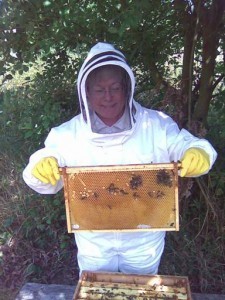Steps on the way to bee-keeping I (guest post by AJLR)
I've always liked bees – whether of the bumble or honey variety. Four or five years ago I started thinking seriously about becoming a bee-keeper but apart from collecting a few books and reading more about it, in a desultory sort of way, I hadn't got much further. Working full-time for an organisation tends to leave relatively few day-time hours to do one's own things in and I knew I'd want to do it properly if I did it at all. Then, from about the same time, there seemed to be more and more news headlines appearing about the ways in which bees of all species were suffering from the cocktail of noxious chemicals we seem to pour over so many things these days, plus the spread of things like the Varroa mite and its baggage of viruses, not to mention the ways in which a lot of commercial bee-farmers appeared to treat the poor creatures. I found myself thinking more and more about what would be involved if I were to take up bee-keeping now rather than when I retired from a full-time day job in a relatively short number of years. Not – of course – that one person extra taking up bee-keeping is going to have any effect on the overall situation but I wanted to understand more and perhaps become involved in some small way. Plus there was a possible beneficial by-product – honey!
So last summer, after lots of musing and kicking ideas around, I was not altogether surprised when my husband suddenly announced that as part of my birthday present he'd bought me a 'hands-on afternoon' with a lady who runs a local bee-keeping business. And it was great – as you can see from the smile on my face in the photo below.
The bees didn't worry me, I moved quietly and gently as instructed, the bee-keeping lady said I was a 'natural' at it (still not sure why – perhaps she says that to most people :)).
After such a positive experience I was very keen finally to get started. The university where I'm based offered me some space for a hive or two*, out on the edge of the campus near the kitchen-garden scheme I'm involved with, and the Students' Union offered to buy a hives' worth of equipment provided that some students could have the chance to become involved if they wished. All that remained was for me to start learning the skills of a bee-keeper…
The first thing one does in such a situation, naturally, is try to involve one's partner in the work. Luckily, my husband had no objections (he's a retired ecologist and wildlife conservation worker), and so we went happily off to do the theory part of the local Bee-keeping Association's** beginners' course in February this year. Two very full days later, we collapsed at home with our brains seething with information about honey bees and bee-keeping generally. Allow me to share a little of this with you:
Worker bees born during the spring and summer live for about six weeks, whereas those born in the autumn usually live about six months as they don't have such a punishing schedule of daily nectar collection (all bees keeping to the hive, for warmth, during winter);
It's the youngest bees, up to an age of about three weeks, who produce wax for the comb, feed the brood of unhatched larvae, clean up generally, tend the queen, produce royal jelly, ventilate the hive, etc. After that age they go out on nectar/pollen collecting flights and keep doing that until they die;
The concept of 'bee-space' was formalised by the Reverend Lorenzo Lorraine Langstroth (1810-1895), a native of Philadelphia, who discovered through observation that honey-bees need a depth of around 1 cm to move around in and that they won't build comb in, or block with propolis, that minimum space. This fact made it possible to structure and build the first fully modern bee-hives, with frames inside that are moveable and can be taken out individually to check for diseases or other problems affecting a hive, extract honey, and check that you have an active laying queen. In most of the thousands of years before this that humans had been working with honey-bees it had been the practice to kill all the bees in a hive or skep in order to extract the honey and wax;
All modern hives now follow the same general internal structure, although they come in a number of external shapes and depths. Most in the US are apparently of a rectangular shape, named after Langstroth, while others – mostly square in shape – widely used in the UK and other countries are the National, the Commercial, the WBC, the Modified Dadant…the list goes on;
A fully-active hive will, in a good summer, produce between 30 and 100 pounds of honey;
A queen honey-bee goes out on one mating flight, about a week to 10 days after she hatched. Provided that the flight is a good one and she mates several times during it, she can lay c.180,000 fertilised eggs over the next three years, using sperm she has kept stored within her body;
Worker bees die after stinging something but the queen doesn't as her sting isn't barbed and so can be retracted back into her body. Drones (males) do not have a sting;
One of the ways in which bee-keepers monitor the numbers of the Varroa mite is by dusting the bees occasionally with a little icing/confectioners' sugar – as the bees comb themselves to clean this off they also tend to dislodge the mites, which then fall through a special wire mesh-covered Varroa floor the keeper has put in at the bottom of the hive and which can be removed and the mites counted. A high count means that an anti-Varroa treatment may be needed.
Drone (male) bees come from unfertilized eggs.
Varroa mites tend to favour laying their eggs in the cells of drone larvae, so at one stage it was thought that culling areas of drone brood in the hive would improve the overall health of the colony. However, further research has found that for a hive to be healthy it needs a good number of drones even though the only thing they apparently do is eat and then wait for a virgin queen's mating flight. Too few drones and the hive doesn't thrive – no-one yet knows why.
When moving hives the often-quoted rule is that you can move them either up to three feet, or no less than three miles, if you want to keep your bees with the hive. In between that and all the active flying bees will just return to where the hive used to be, when they come back after a flight.
So, you can probably see why our brains were full to overflowing with these and many more facts. An introduction to the practical side of things was covered in the hands-on part of the course, that we had a few days ago. I'll be sharing some of the particular joys of this in a second post.
* * *
* We have got room for a hive in our back garden at home but the garden has a public footpath, running along outside part of one of our boundary hedges, that is used by children going to the local primary school. While I'm a learner bee-keeper I wouldn't want to inadvertently upset my bees and have them suddenly take off in revenge after any nearby (and probably noisy) children!
** The UK has a number of local, county, bee-keeping associations, most of which are affiliated to the British Beekeepers Association. The BBKA provides information, advice both scientific and practical, and help with such things as how to deal with notifiable diseases, basic and advanced training programmes, etc. A very useful body. We could have just gone out and bought some bees and a hive – nothing to stop us doing that – but we wanted the mentoring support and information that comes with being part of our local association.
Robin McKinley's Blog
- Robin McKinley's profile
- 7240 followers




